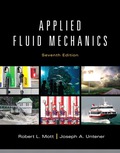
Applied Fluid Mechanics
7th Edition
ISBN: 9780133414622
Author: UNTENER
Publisher: YUZU
expand_more
expand_more
format_list_bulleted
Textbook Question
Chapter 19, Problem 19.27PP
Forthe conditions shown in figs. 19.719- 19.10 0, complete the design of the duct system by specifying the sizes for all duct sections necessary to achieve a system that is balanced when it carries the flow rates shown. Compute the pressure at the fan outlet, assuming that the final outlets from the duct system are to atmospheric pressure. When an inlet duct section is shown, also complete its design and compute the pressure at the fan inlet. Note that there is no single best solution to these problems, and several design decisions must be made. It may be desirable to change certain features of the suggested system design to improve its operation or to make it simpler to achieve a balanced system.
Expert Solution & Answer
Want to see the full answer?
Check out a sample textbook solution
Students have asked these similar questions
my ID# 016948724. Please solve this problem step by step
My ID# 016948724 please find the forces for Fx=0: fy=0: fz=0: please help me to solve this problem step by step
My ID# 016948724 please solve the proble step by step find the forces fx=o: fy=0; fz=0; and find shear moment and the bending moment diagran please draw the diagram for the shear and bending moment
Chapter 19 Solutions
Applied Fluid Mechanics
Ch. 19 - Determine the velocity of flow and the friction...Ch. 19 - Repeat Problem 19.1 O for duct diameters of 16,...Ch. 19 - Prob. 19.3PPCh. 19 - Determine the velocity of flow and the friction...Ch. 19 - Repeat Problem 19.40 for duct diameters of...Ch. 19 - Prob. 19.6PPCh. 19 - Prob. 19.7PPCh. 19 - '19.8 A branch duct for a heating system measures...Ch. 19 - Prob. 19.9PPCh. 19 - Prob. 19.10PP
Ch. 19 - A branch duct for a heating system measures 75250...Ch. 19 - Prob. 19.12PPCh. 19 - Prob. 19.13PPCh. 19 - Prob. 19.14PPCh. 19 - Repeat Problem 19.14, but use a five-piece elbowCh. 19 - Prob. 19.16PPCh. 19 - Prob. 19.17PPCh. 19 - Prob. 19.18PPCh. 19 - Prob. 19.19PPCh. 19 - Prob. 19.20PPCh. 19 - Compute the pressure drop as 0.20m3/s of air flows...Ch. 19 - Prob. 19.22PPCh. 19 - Compute the pressure drop as 0.85m3/s of air flows...Ch. 19 - A section of duct system consists of 42 ft of...Ch. 19 - A section of duct system consists of 38 ft of...Ch. 19 - The intake duct to a fan consists of intake...Ch. 19 - Forthe conditions shown in figs. 19.719- 19.10 0,...Ch. 19 - Forthe conditions shown in figs. 19.719- 19.10 0,...Ch. 19 - Prob. 19.29PPCh. 19 - Forthe conditions shown in figs. 19.719- 19.10 0,...
Knowledge Booster
Learn more about
Need a deep-dive on the concept behind this application? Look no further. Learn more about this topic, mechanical-engineering and related others by exploring similar questions and additional content below.Similar questions
- My ID#016948724 please solve this problems and show me every step clear to follow pleasearrow_forwardMy ID# 016948724arrow_forwardPlease do not use any AI tools to solve this question. I need a fully manual, step-by-step solution with clear explanations, as if it were done by a human tutor. No AI-generated responses, please.arrow_forward
- Please do not use any AI tools to solve this question. I need a fully manual, step-by-step solution with clear explanations, as if it were done by a human tutor. No AI-generated responses, please.arrow_forwardPlease do not use any AI tools to solve this question. I need a fully manual, step-by-step solution with clear explanations, as if it were done by a human tutor. No AI-generated responses, please.arrow_forward[Q2]: The cost information supplied by the cost accountant is as follows:Sales 20,00 units, $ 10 per unitCalculate the (a/ newsale guantity and (b) new selling price to earn the sameVariable cost $ 6 per unit, Fixed Cost $ 30,000, Profit $ 50,000profit ifi) Variable cost increases by $ 2 per unitil) Fixed cost increase by $ 10,000Ili) Variable cost increase by $ 1 per unit and fixed cost reduces by $ 10,000arrow_forward
- can you please help me perform Visual Inspection and Fractography of the attatched image: Preliminary examination to identify the fracture origin, suspected fatigue striation, and corrosion evidences.arrow_forwardcan you please help[ me conduct Causal Analysis (FTA) on the scenario attatched: FTA diagram which is a fault tree analysis diagram will be used to gain an overview of the entire path of failure from root cause to the top event (i.e., the swing’s detachment) and to identify interactions between misuse, material decay and inspection errors.arrow_forwardhi can you please help me in finding the stress intensity factor using a k-calcluator for the scenario attathced in the images.arrow_forward
arrow_back_ios
SEE MORE QUESTIONS
arrow_forward_ios
Recommended textbooks for you
 Refrigeration and Air Conditioning Technology (Mi...Mechanical EngineeringISBN:9781305578296Author:John Tomczyk, Eugene Silberstein, Bill Whitman, Bill JohnsonPublisher:Cengage Learning
Refrigeration and Air Conditioning Technology (Mi...Mechanical EngineeringISBN:9781305578296Author:John Tomczyk, Eugene Silberstein, Bill Whitman, Bill JohnsonPublisher:Cengage Learning

Refrigeration and Air Conditioning Technology (Mi...
Mechanical Engineering
ISBN:9781305578296
Author:John Tomczyk, Eugene Silberstein, Bill Whitman, Bill Johnson
Publisher:Cengage Learning
Intro to Compressible Flows — Lesson 1; Author: Ansys Learning;https://www.youtube.com/watch?v=OgR6j8TzA5Y;License: Standard Youtube License